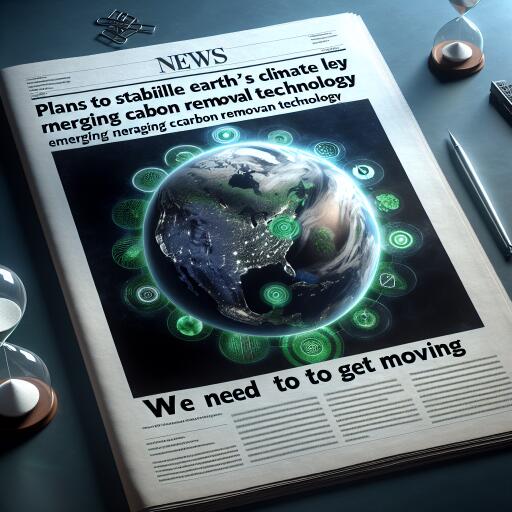
World News | Plans to Stabilise Earth’s Climate Rely on Emerging Carbon Removal Technology – We Need to Get Moving | LatestLY
As global carbon emissions from fossil fuels continue to surge, predictions suggest that 2024 may become the hottest year recorded worldwide. To limit the increase in global temperatures to 1.5°C, it has become evident that reducing emissions alone is insufficient. We also urgently need to eliminate billions of tonnes of atmospheric carbon dioxide annually.
The Intergovernmental Panel on Climate Change (IPCC) highlights the critical role of carbon dioxide removal technology in achieving both global and national net-zero emissions. Achieving net zero is impossible without this technology, as the reduction of greenhouse gas emissions is progressing too slowly.
Carbon removal does not come without its challenges, including its potentially high costs and consumption of valuable resources such as energy, water, and land. However, with climate projections forecasting over 3°C of warming under current policies, it is imperative to cut emissions drastically and manage any remaining emissions through carbon removal.
The scientific consensus now recognizes the pressing need for carbon dioxide removal. Understanding the available technologies and their potential is crucial for navigating Australia’s path to a net-zero future.
The Need for Carbon Dioxide Removal
Carbon dioxide removal involves enhancing natural processes to store carbon in trees, soil, rocks, and oceans, distinguishing it from carbon capture and storage, which aims to prevent carbon from entering the atmosphere in the first place.
Australia’s Climate Change Authority targets net-zero emissions by 2050, yet some emissions – potentially representing about 25% of 2005 levels – are expected to persist. This necessitates addressing approximately 133 million tonnes of emissions annually by mid-century, equating to billions of tonnes of carbon removal over the coming 25 years.
Exploring technologies for atmospheric carbon dioxide removal is among the federal government’s top science and research priorities.
Required Technologies
Carbon dioxide removal technologies are classified into “conventional” (nature-based) and “novel” (advanced) categories.
Conventional methods rely on biological processes, including afforestation, soil carbon enhancement, and boosting carbon stores in coastal systems like mangroves. While these techniques typically retain carbon for shorter periods, ranging from decades to a century, they are nearing saturation and face vulnerabilities in a warming climate. For instance, forest fires are increasingly re-releasing vast amounts of sequestered carbon into the atmosphere.
To achieve substantial net-zero emissions, more durable carbon removal solutions are essential. Promising innovations include incorporating crushed carbonate or silicate rocks into the ocean or agricultural fields. Research indicates that waste rock from mining could be repurposed effectively for this goal.
Alarmingly, new carbon removal techniques currently account for less than 0.1% of global efforts.
Avoiding Potential Challenges
Carbon removal technologies pose certain risks and potential compromises. With a market projected at up to US$1.1 trillion by 2050, there is a temptation to overstate their effectiveness.
To address this, the IPCC is developing reliable methods for verifying actual carbon removal amounts, ensuring they can be accurately incorporated into national records. This promotes transparency and helps mitigate risks of greenwashing or false claims.
Furthermore, these technologies may have environmental impacts. For example, tree planting could compete with agriculture or conservation efforts for resources like water and land, challenges that climate change may exacerbate. Emerging techniques, like direct air capture and storage, still face technical difficulties related to energy consumption.
Consideration of the interests and rights of Australia’s Indigenous communities is paramount. While initial surveys show positive responses to such climate interventions, more engagement is needed to discuss the impact of specific removal strategies.
Building a New Industry in Australia
Australia’s expansive landscapes and oceans provide exceptional capacity for carbon storage compared to other countries. Coupled with abundant renewable energy resources and a skilled workforce, Australia is well-positioned to advance carbon removal technologies.
Transitioning to large-scale carbon dioxide removal will require creating an entirely new industry with its own infrastructure and frameworks, similar to the renewable energy sector’s development around solar and wind technologies. Efforts by organizations such as CSIRO are already underway, but further national discussion, planning, and strategy formulation are necessary.
While prevention remains superior to cure—prioritizing emissions reduction over carbon removal—we face an urgent timeline. Atmospheric carbon dioxide levels are dangerously elevated, and achieving net-zero emissions by 2050 is critical.
Carbon dioxide removal is now an indispensable component of climate action, alongside substantial and prompt emissions reductions. There is no time to waste in advancing permanent carbon removal methods if we intend to preserve the Earth’s climate for future generations.





Leave a Reply